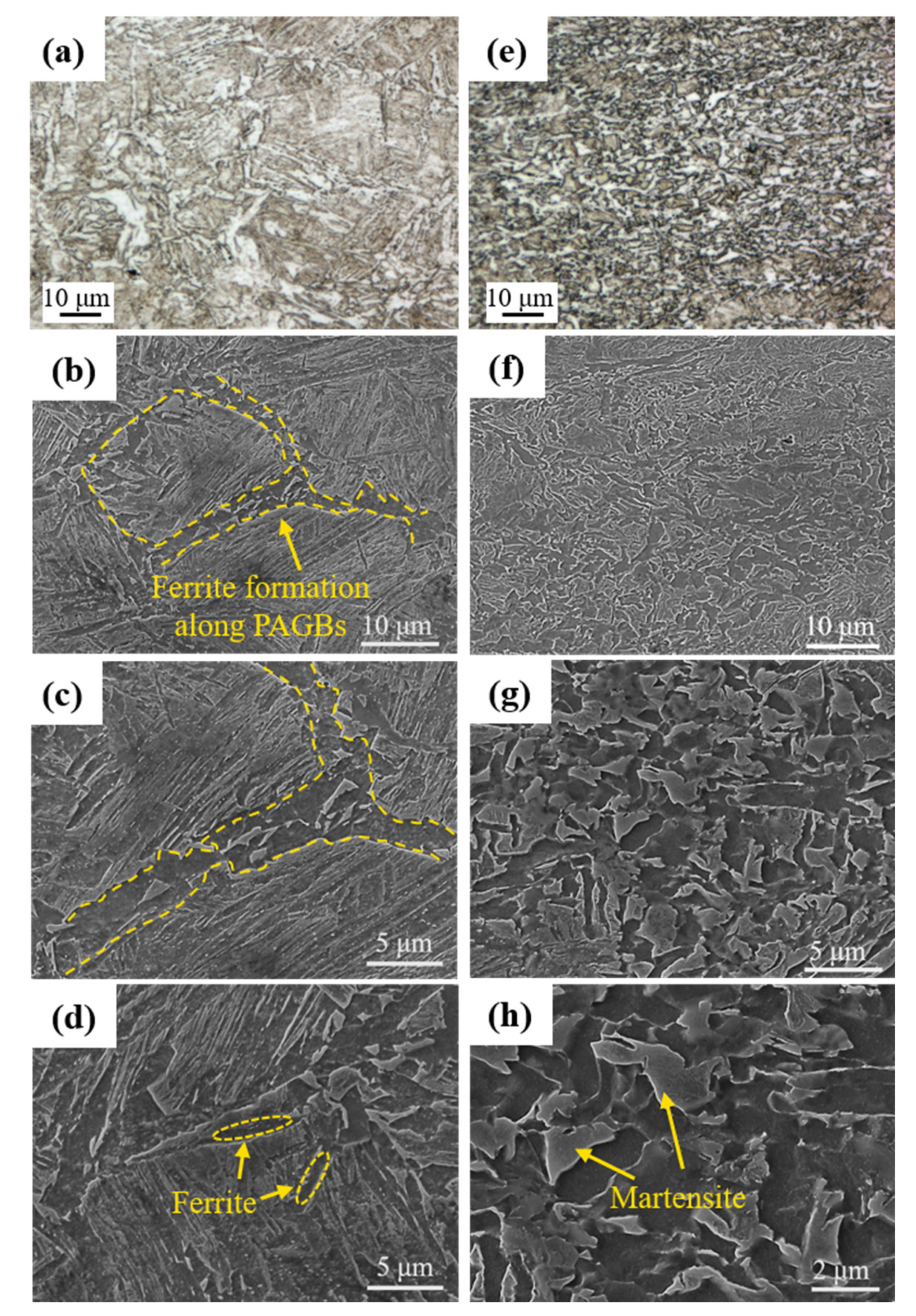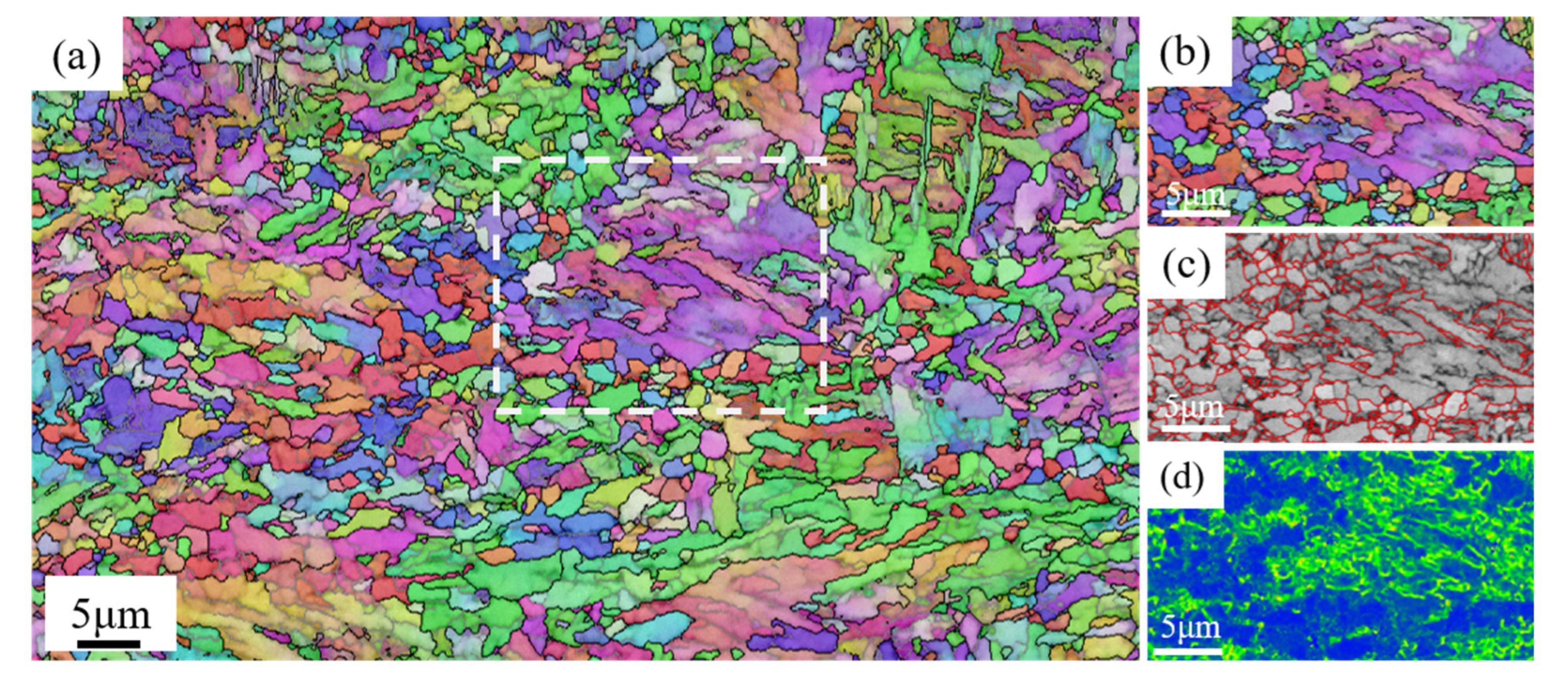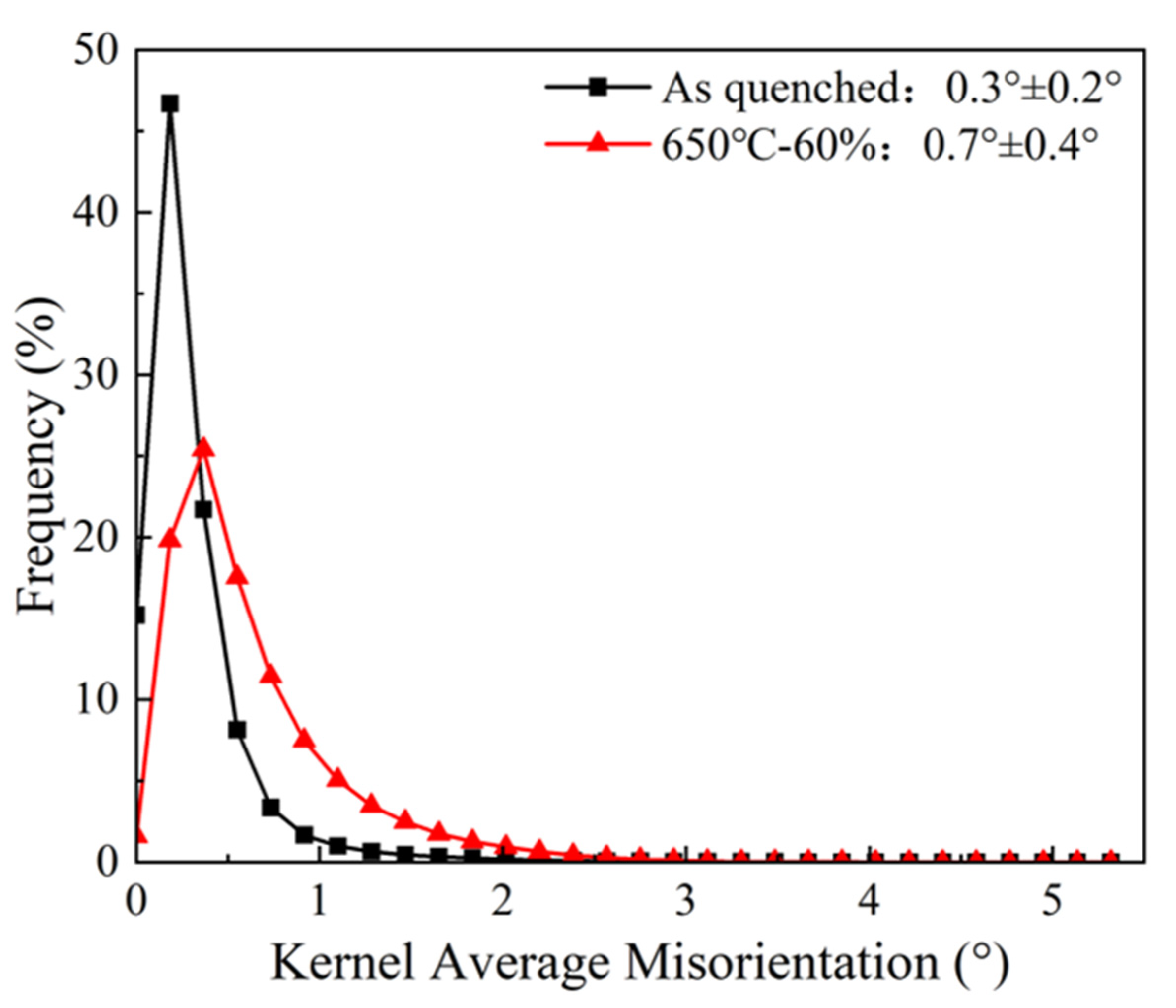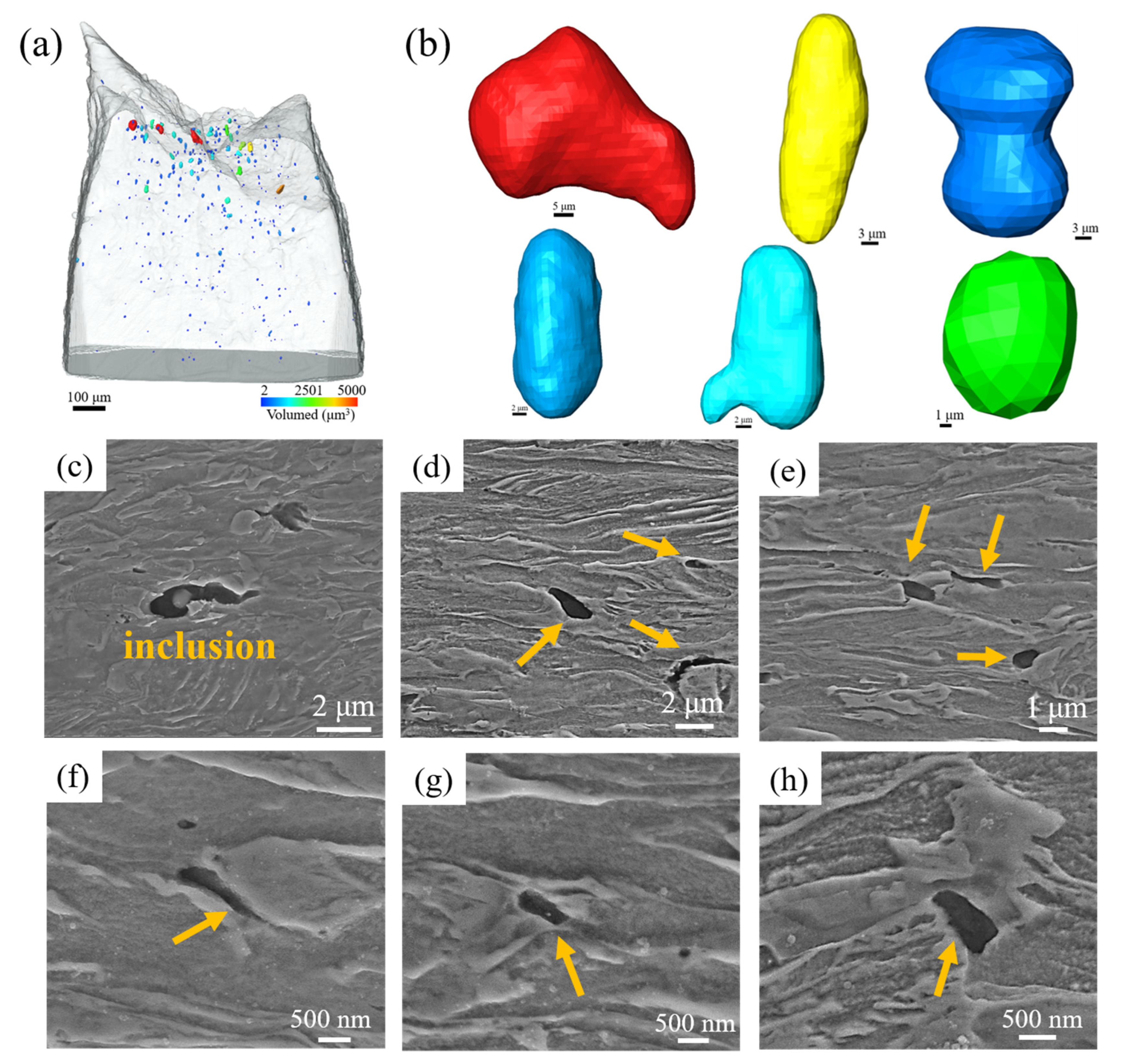Microstructure and Mechanical Properties of Ultrafine-Grained Dual-Phase 0.1C3Mn Steel Processed by Warm Deformation
Abstract
1. Introduction
2. Materials and Methods
3. Results
4. Discussion
5. Conclusions
Author Contributions
Funding
Data Availability Statement
Conflicts of Interest
References
- Sun, B.; Kwiatkowski da Silva, A.; Wu, Y.; Ma, Y.; Chen, H.; Scott, C.; Ponge, D.; Raabe, D. Physical metallurgy of medium-Mn advanced high-strength steels. Int. Mater. Rev. 2023, 68, 786–824. [Google Scholar] [CrossRef]
- Kazakova, A.A.; Churyumov, A.Y. Microstructure and Mechanical Properties of Fe-30Mn-10Al-3.3Si-1C Light-Weight Steel. Materials 2025, 18, 1258. [Google Scholar] [CrossRef] [PubMed]
- Lv, X.; Wang, X.; Lan, A.; Qiao, J. Synergistic Effect of Al and Ni on Microstructure Evolutions and Mechanical Properties of Fe-Mn-Al-C Low-Density Steels. Metals 2024, 14, 495. [Google Scholar] [CrossRef]
- Fonstain, N. Advanced High Strength Steels: Physical Metallurgy, Design, Processing, and Properties; Springer International Publishing: Cham, Switzerland, 2015. [Google Scholar]
- Allain, S.Y.P.; Pushkareva, I.; Teixeira, J.; Gouné, M.; Scott, C. Dual-Phase Steels: The First Family of Advanced High Strength Steels. In Encyclopedia of Materials: Metals and Alloys; Caballero, F.G., Ed.; Elsevier: Oxford, UK, 2022; pp. 37–62. [Google Scholar]
- Ismail, K.; Perlade, A.; Jacques, P.J.; Pardoen, T. Outstanding cracking resistance of fibrous dual phase steels. Acta Mater. 2021, 207, 116700. [Google Scholar] [CrossRef]
- Frómeta, D.; Parareda, S.; Lara, A.; Molas, S.; Casellas, D.; Jonsén, P.; Calvo, J. Identification of fracture toughness parameters to understand the fracture resistance of advanced high strength sheet steels. Eng. Fract. Mech. 2020, 229, 106949. [Google Scholar] [CrossRef]
- Frómeta, D.; Lara, A.; Grifé, L.; Dieudonné, T.; Dietsch, P.; Rehrl, J.; Suppan, C.; Casellas, D.; Calvo, J. Fracture Resistance of Advanced High-Strength Steel Sheets for Automotive Applications. Metall. Mater. Trans. A 2021, 52, 840–856. [Google Scholar] [CrossRef]
- Lai, Q.; Brassart, L.; Bouaziz, O.; Gouné, M.; Verdier, M.; Parry, G.; Perlade, A.; Bréchet, Y.; Pardoen, T. Influence of martensite volume fraction and hardness on the plastic behavior of dual-phase steels: Experiments and micromechanical modeling. Int. J. Plast. 2016, 80, 187–203. [Google Scholar] [CrossRef]
- Kadkhodapour, J.; Schmauder, S.; Raabe, D.; Ziaei-Rad, S.; Weber, U.; Calcagnotto, M. Experimental and numerical study on geometrically necessary dislocations and non-homogeneous mechanical properties of the ferrite phase in dual phase steels. Acta Mater. 2011, 59, 4387–4394. [Google Scholar] [CrossRef]
- Gao, B.; Liu, Y.; Chen, X.; Sui, Y.; Sun, W.; Xiao, L.; Zhou, H. Heterogeneous plastic deformation and HDI strengthening of the heterostructured dual-phase steels investigated by in-situ SEM-DIC. Mater. Sci. Eng. A 2024, 893, 146149. [Google Scholar] [CrossRef]
- Lai, Q.; Bouaziz, O.; Goune, M.; Brassart, L.; Verdier, M.; Parry, G.; Perlade, A.; Brechet, Y.; Pardoen, T. Damage and fracture of dual-phase steels: Influence of martensite volume fraction. Mater. Sci. Eng. A 2015, 646, 322–331. [Google Scholar] [CrossRef]
- Landron, C.; Bouaziz, O.; Maire, E.; Adrien, J. Experimental investigation of void coalescence in a dual phase steel using X-ray tomography. Acta Mater. 2013, 61, 6821–6829. [Google Scholar] [CrossRef]
- Shi, P.; Ren, Y.; Zhang, X.; Wang, H.; Chen, J.; Pei, Y.; Yan, J.; Zheng, H.; Zhang, J. Role of martensite morphology on mechanical response of dual-phase steel produced by partial reversion from martensite. Mater. Sci. Eng. A 2024, 893, 146116. [Google Scholar] [CrossRef]
- Xu, H.; Jia, Z.; Lai, Q. Impacts of Morphology on the Fracture Resistance of the High-Strength Dual-Phase Steels. Materials 2025, 18, 2253. [Google Scholar] [CrossRef] [PubMed]
- Mazinani, M.; Poole, W.J. Effect of Martensite Plasticity on the Deformation Behavior of a Low-Carbon Dual-Phase Steel. Metall. Mater. Trans. A 2007, 38, 328–339. [Google Scholar] [CrossRef]
- Park, M.h.; Fujimura, Y.; Shibata, A.; Tsuji, N. Effect of martensite hardness on mechanical properties and stress/strain-partitioning behavior in ferrite plus martensite dual-phase steels. Mater. Sci. Eng. A 2024, 916, 147301. [Google Scholar] [CrossRef]
- Azuma, M.; Goutianos, S.; Hansen, N.; Winther, G.; Huang, X. Effect of hardness of martensite and ferrite on void formation in dual phase steel. Mater. Sci. Technol. 2012, 28, 1092–1100. [Google Scholar] [CrossRef]
- Ogatsu, K.; Ogawa, T.; Chen, T.T.; Sun, F.; Adachi, Y. Dramatic improvement in strength–ductility balance of dual-phase steels by optimizing features of ferrite phase. J. Mater. Res. Technol. 2025, 35, 289–297. [Google Scholar] [CrossRef]
- Park, M.h.; Shibata, A.; Harjo, S.; Tsuji, N. Grain refinement of dual phase steel maximizes deformation ability of martensite, leading to simultaneous enhancement of strength and ductility. Acta Mater. 2025, 292, 121061. [Google Scholar] [CrossRef]
- Pelligra, C.; Samei, J.; Kang, J.; Wilkinson, D.S. The effect of vanadium on microstrain partitioning and localized damage during deformation of unnotched and notched DP1300 steels. Int. J. Plast. 2022, 158, 103425. [Google Scholar] [CrossRef]
- Samei, J.; Zhou, L.; Kang, J.; Wilkinson, D.S. Microstructural analysis of ductility and fracture in fine-grained and ultrafine-grained vanadium-added DP1300 steels. Int. J. Plast. 2019, 117, 58–70. [Google Scholar] [CrossRef]
- Xu, X.N.; Li, X.L.; Gou, X.Q.; Li, Y.; Ye, Q.B.; Tian, Y. Synergistic enhancement of strength, ductility, and toughness in a low carbon micro-alloy steel with an ultrafine-grained heterogeneous lamellar structure. Mater. Sci. Eng. A 2023, 878, 145205. [Google Scholar] [CrossRef]
- Sun, J.; Xu, B.; Wang, H.; Guo, S.; Yan, Z.; Zhang, J.; Liu, Y. Effect of prior-austenite grain size on the microstructure and mechanical properties of ultrafine-grained dual-phase layer-structured steel produced by hot rolling of intercritical annealed bainite. J. Mater. Res. Technol. 2023, 23, 2440–2453. [Google Scholar] [CrossRef]
- Scott, C.P.; Shalchi Amirkhiz, B.; Pushkareva, I.; Fazeli, F.; Allain, S.Y.P.; Azizi, H. New insights into martensite strength and the damage behaviour of dual phase steels. Acta Mater. 2018, 159, 112–122. [Google Scholar] [CrossRef]
- Azizi-Alizamini, H.; Militzer, M.; Poole, W.J. Formation of Ultrafine Grained Dual Phase Steels through Rapid Heating. ISIJ Int. 2011, 51, 958–964. [Google Scholar] [CrossRef]
- Calcagnotto, M.; Adachi, Y.; Ponge, D.; Raabe, D. Deformation and fracture mechanisms in fine- and ultrafine-grained ferrite/martensite dual-phase steels and the effect of aging. Acta Mater. 2011, 59, 658–670. [Google Scholar] [CrossRef]
- Son, Y.I.; Lee, Y.K.; Park, K.T.; Lee, C.S.; Shin, D.H. Ultrafine grained ferrite-marten site dual phase steels fabricated via equal channel angular pressing: Microstructure and tensile properties. Acta Mater. 2005, 53, 3125–3134. [Google Scholar] [CrossRef]
- Dong, H.; Sun, X. Deformation induced ferrite transformation in low carbon steels. Curr. Opin. Solid State Mater. Sci. 2005, 9, 269–276. [Google Scholar] [CrossRef]
- Beladi, H.; Kelly, G.L.; Hodgson, P.D. Ultrafine grained structure formation in steels using dynamic strain induced transformation processing. Int. Mater. Rev. 2007, 52, 14–28. [Google Scholar] [CrossRef]
- Hodgson, P.D.; Hickson, M.R.; Gibbs, R.K. Ultrafine ferrite in low carbon steel. Scr. Mater. 1999, 40, 1179–1184. [Google Scholar] [CrossRef]
- Hou, F.; Yu, B.; Akinobu, S.; Tsuji, N. Microstructure evolution during thermomechanical processing in 3Mn-0.1C medium-Mn steel. Mater. Sci. Technol. 2019, 35, 2101–2108. [Google Scholar] [CrossRef]
- Rodriguez-Galeano, K.F.; Nutter, J.; Azakli, Y.; Slater, C.; Rainforth, W.M. The effect of the increased strain per pass during the hot-rolling and its effect on the tensile properties of V-Mo and Cr-V-Mo microalloyed dual-phase steels. J. Mater. Sci. 2024, 59, 22228–22249. [Google Scholar] [CrossRef]
- Zhao, L.; Park, N.; Tian, Y.; Shibata, A.; Tsuji, N. Dynamic Transformation Mechanism for Producing Ultrafine Grained Steels. Adv. Eng. Mater. 2018, 20, 1701016. [Google Scholar] [CrossRef]
- Zhao, J.; Wang, H.; Koenigsmann, K.; Ran, X.; Zhang, P.; Zhang, S.; Li, Y.; Liu, H.; Liu, H.; Ren, L.; et al. Warm Deformation at the (α plus γ) Dual-Phase Region to Fabricate 2 GPa Ultrafine-Grained TRIP Steels. Metals 2023, 13, 1997. [Google Scholar] [CrossRef]
- Shu, W.; Fan, Y.; Li, R.; Liu, Q.; Lai, Q. Formation of Ultrafine-Grained Dual-Phase Microstructure by Warm Deformation of Austenite in High-Strength Steel. Materials 2025, 18, 1341. [Google Scholar] [CrossRef] [PubMed]
- Xiong, Z.; Jacques, P.J.; Perlade, A.; Pardoen, T. Characterization and Control of the Compromise Between Tensile Properties and Fracture Toughness in a Quenched and Partitioned Steel. Metall. Mater. Trans. A 2019, 50, 3502–3513. [Google Scholar] [CrossRef]
- Lai, Q.; Chen, Z.; Wei, Y.; Lu, Q.; Ma, Y.; Wang, J.; Fan, G. Towards the understanding of fracture resistance of an ultrahigh-strength martensitic press-hardened steel. J. Mater. Res. Technol. 2023, 27, 1996–2006. [Google Scholar] [CrossRef]
- Maloney, J.L.; Garrison, W.M. The effect of sulfide type on the fracture behavior of HY180 steel. Acta Mater. 2005, 53, 533–551. [Google Scholar] [CrossRef]
- Liu, Q.; Hansen, N. Geometrically necessary boundaries and incidental dislocation boundaries formed during cold deformation. Scr. Metall. Mater. 1995, 32, 1289–1295. [Google Scholar] [CrossRef]
- Lacroix, S.; Bréchet, Y.; Véron, M.; Quidort, D.; Kandel, M.; Iung, T. Influence of Deformation on Austenite to Ferrite Transformation in Low Carbon Steels: Experimental Approach and Modelling. In Proceedings of the Materials Science and Technology Conference 2003, Chicago, IL, USA, 9–12 November 2003; pp. 367–379. [Google Scholar]
- Hurley, P.J.; Hodgson, P.D. Formation of ultra-fine ferrite in hot rolled strip: Potential mechanisms for grain refinement. Mater. Sci. Eng. A 2001, 302, 206–214. [Google Scholar] [CrossRef]
- Hickson, M.R.; Russell, R.K.; Hodgson, P.D. The effect of chemistry on the formation of ultrafine ferrite in steel. ISIJ Int. 1999, 39, 1176–1180. [Google Scholar] [CrossRef]
- DeBoer, A.; Benrabah, I.E.; Rampelberg, C.; Geandier, G.; Zurob, H. In-situ investigations on the dynamic transformation in steel near the Ae3 temperature. Scr. Mater. 2025, 265, 116737. [Google Scholar] [CrossRef]
- Tang, A.; Liu, H.; Chen, R.; Liu, G.; Lai, Q.; Zhong, Y.; Wang, L.; Wang, J.; Lu, Q.; Shen, Y. Mesoscopic origin of damage nucleation in dual-phase steels. Int. J. Plast. 2021, 137, 102920. [Google Scholar] [CrossRef]










| Sample | YS (MPa) | UE | TS (MPa) | εf | ||
|---|---|---|---|---|---|---|
| Eng | True | Eng | True | |||
| As-quenched | 867 ± 25 | 0.034 ± 0.004 | 0.033 ± 0.004 | 1090 ± 21 | 1128 ± 34 | 0.82 ± 0.06 |
| 650 °C-30% | 780 ± 10 | 0.048 ± 0.004 | 0.047 ± 0.003 | 1037 ± 16 | 1104 ± 25 | 0.79 ± 0.08 |
| 650 °C-60% | 635 ± 48 | 0.068 ± 0.003 | 0.066 ± 0.003 | 938 ± 33 | 1033 ± 11 | 0.96 ± 0.08 |
Disclaimer/Publisher’s Note: The statements, opinions and data contained in all publications are solely those of the individual author(s) and contributor(s) and not of MDPI and/or the editor(s). MDPI and/or the editor(s) disclaim responsibility for any injury to people or property resulting from any ideas, methods, instructions or products referred to in the content. |
© 2025 by the authors. Licensee MDPI, Basel, Switzerland. This article is an open access article distributed under the terms and conditions of the Creative Commons Attribution (CC BY) license (https://creativecommons.org/licenses/by/4.0/).
Share and Cite
Wang, Y.; Liu, C.; Lai, Q. Microstructure and Mechanical Properties of Ultrafine-Grained Dual-Phase 0.1C3Mn Steel Processed by Warm Deformation. Metals 2025, 15, 699. https://doi.org/10.3390/met15070699
Wang Y, Liu C, Lai Q. Microstructure and Mechanical Properties of Ultrafine-Grained Dual-Phase 0.1C3Mn Steel Processed by Warm Deformation. Metals. 2025; 15(7):699. https://doi.org/10.3390/met15070699
Chicago/Turabian StyleWang, Yongkang, Chenglu Liu, and Qingquan Lai. 2025. "Microstructure and Mechanical Properties of Ultrafine-Grained Dual-Phase 0.1C3Mn Steel Processed by Warm Deformation" Metals 15, no. 7: 699. https://doi.org/10.3390/met15070699
APA StyleWang, Y., Liu, C., & Lai, Q. (2025). Microstructure and Mechanical Properties of Ultrafine-Grained Dual-Phase 0.1C3Mn Steel Processed by Warm Deformation. Metals, 15(7), 699. https://doi.org/10.3390/met15070699




